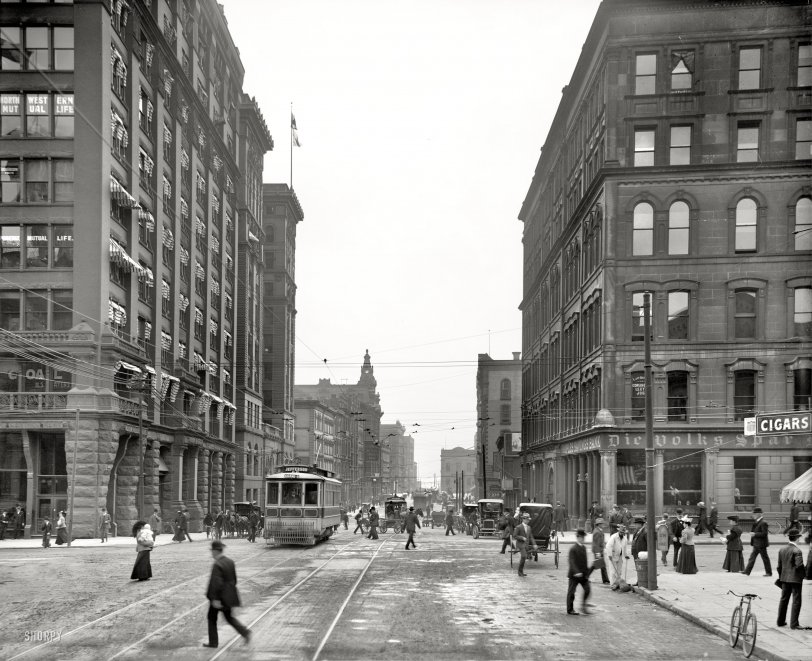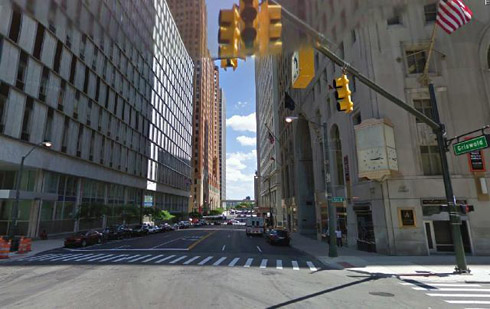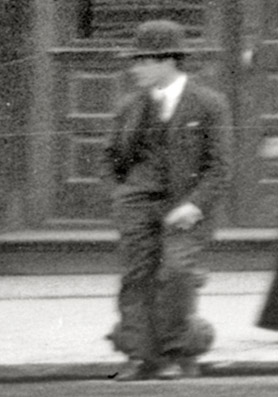


Framed or unframed, desk size to sofa size, printed by us in Arizona and Alabama since 2007. Explore now.
Shorpy is funded by you. Patreon contributors get an ad-free experience.
Learn more.

- Indiana Harbor Belt abides
- Freezing haze
- Corrections (for those who care)
- C&NW at Nelson
- Fallen Flags
- A dangerous job made worse
- Water Stop
- Passenger trains have right of way over freights?
- Coal
- Never ceases to amaze me.
- Still chuggin' (in model form)
- Great shot
- Westerly Breeze
- For the men, a trapeze
- Tickled
- Sense of loneliness ...
- 2 cents
- Charm City
- What an Outrage
- Brighton Park
- Catenary Supports
- Just a Little Before I was Born
- Afternoon normal
- The Flat Iron Cafe survives
- Aging in Place
- Raise your hand
- Good and Bad
- Oh, the 70's
- Nooooooi
- The aluminum tubing
Print Emporium
The Busy Corner: 1906

Detroit circa 1906. "Griswold Street at Fort." The comings and goings of a century ago, cross-sectioned and flash-frozen. 8x10 glass negative. View full size.
Re: The cowcatcher
Streetcar fenders were supposed to fold and scoop up folks that fell in front of the car to keep them from going under.
Faked "accidents" were commonplace back then, when traction companies were bleeding edge tech and at least for a while well off.
Pedestrian Safety Device.
"Cowcatchers" on streetcars were the subject of numerous patent applications. They are intended to reduce injuries by keeping victims from going under the car. And yes, with steel wheels on steel rails, the brakes were that bad.
One-legged urchins
The "cowcatcher" was indeed necessary, but not because of the brakes. Little boys can move a lot faster than a motorman can reach for a brake lever. One-legged boys were not uncommon in the big cities. Double amputees as well. Al Capp, the celebrated creator of the Li'l Abner comic strip, lost one of his legs to a streetcar when he was a youngster. The only way the builders might have prevented such injuries would have been to install a catcher that went completely around the car, right down to street level. Even then, little boys, being inventive and daring as they are, would have found a way to be mangled.
The cowcatcher
on the streetcar freaks me out --- were the brakes so bad on the car that it was deemed necessary? I wonder how many folks were impaled crossing the street.
Re: Bike Riders
The curb is holding up the bike. Roll the pedal back to rest on the curb and it will stand up. I do it all the time with my bikes none of which have a kick stand. This is a common image in many of the Shorpy photos.
And Today....
Pretty sure this view is looking south, towards the Detroit River. Here it is today.

That balancing bike
brought back a few memories, note where the right pedal is, that is holding the bike up, a trick we learned on bikes with no gears.
Upright bikes
Bikes back then were "fixies." They had no braking other than backpedaling! Your pedals stayed where you put them, made it easy to park against the curb.
Temperance, Industry , Economy
The People's Savings Bank in Detroit was originally located one block away at the southeast corner of Congress and Griswold. Below is a circa 1878 advertisement for the bank - note the beehive in the ad and also on the corner of the bank's facade in the photo.

The bottom line of the ad indicates they were paying "Five Percent Interest"!
Use of the spoken and written German language in the USA abruptly disappeared once the United States entered the Great War. In April 1918, my German-born cousin who was an ordained priest had to get a license to preach to his flock of German immigrants in West Point, NE because under Nebraska's Sedition Law, "no alien enemy may act in the capacity of preacher... without having first filed an application in district court"
Gotta love those streetcars!
I drove a trolley car similar to this one at an outdoor museum once. The motor control was fairly easy to understand, but those mechanical brakes were a bear! If you didn't finesse those things you could easily throw all your passengers onto the floor -- and I did! I have a great deal of respect for motormen, past and distant past.
Mr. Rumplepants
I have to say I have never seen a suit of clothes quite like this. If this were the 1960s hippy era I might understand, but this seems out of character for the period. Perhaps he is breaking the pants in for a tall friend.
[That's a fire hydrant, not rumply pants. - Dave]

Die Volks Sparkasse
On the corner, you can see that the Peoples Savings Bank put up a translation in German of its name: "Die Volks Spar Kasse." Presumably to cater for the thriving German community in the Detroit area.
Bike riders
It's interesting to see how casual bike owners were in this instance. Bikes are parked all over the place with no worry about locking them up. Love the one in the right foreground that seems to be standing upright without the assistance of a kickstand (although it might be hidden from view). Can't believe the curb is holding it up!
























On Shorpy:
Today’s Top 5